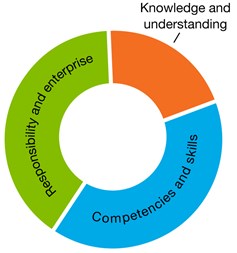Explore content
Health and Physical Education
The Australian Curriculum: Health and Physical Education (HPE) can play an important role in developing consumer and financial literacy in young people. HPE supports the development of the dimensions of consumer and financial literacy as shown in the diagram below.

Approximate proportion of the dimensions addressed in Health and Physical Education
HPE provides many opportunities to link the knowledge, understanding and skills needed for active and healthy living to consumer and financial literacy. The study of HPE strengthens students’ sense of self, helps them to understand their emotions and supports them to build on personal and community strengths to enhance physical activity, safety and wellbeing. Students learn to make decisions about their own health, safety and wellbeing and to take action to promote the health and wellbeing of their communities.
As they consider choices that affect their own and others’ health and wellbeing, students acquire a range of skills that will help them make sound and informed financial decisions throughout their lives. For example, students might consider the impact of affordability on diet, exercise and lifestyle choices or examine issues such as the impact of alcohol abuse on both health and finances. The study of HPE also promotes consumer awareness by enabling students to consider the various influences on consumer behaviour, such as identities, emotions, social pressure and marketing strategies.
The strand of movement and physical activity has not been included in this mapping. However, there are opportunities to include aspects of this strand in the teaching and learning of consumer and financial literacy. For example, enterprise skills such as collaboration and leadership can be developed in the context of playing games and sports. The HPE focus areas can also be used as real-world contexts for teaching consumer and financial literacy. For example, students might be asked to consider how and why they should budget for gym membership (health benefits of physical activity), the impact of the cost on people’s involvement in adventure activities (challenge and adventure activities), the ways in which games and sports affect and are affected by the economy (games and sports) or how to budget for recreational choices (lifelong physical activity).
Moneysmart for teachers provides a number of interdisciplinary units and interactive activities that either focus on or include aspects of the HPE curriculum. Access a list of relevant resources that link to the Australian Curriculum: Health and Physical Education using the right-hand menu.
Understanding emotions
Examine the influence of emotional responses on behaviour and relationships (ACPPS056)
Health literacy
Recognise how media and important people in the community influence personal attitudes, beliefs, decisions and behaviours (ACPPS057)
Making healthy and safe choices
Plan and practise strategies to promote health, safety and wellbeing (ACPPS054)
Identities
Examine how identities are influenced by people and places (ACPPS051)
Community health promotion
Investigate the role of preventive health in promoting and maintaining health, safety and wellbeing for individuals and their communities (ACPPS058)


